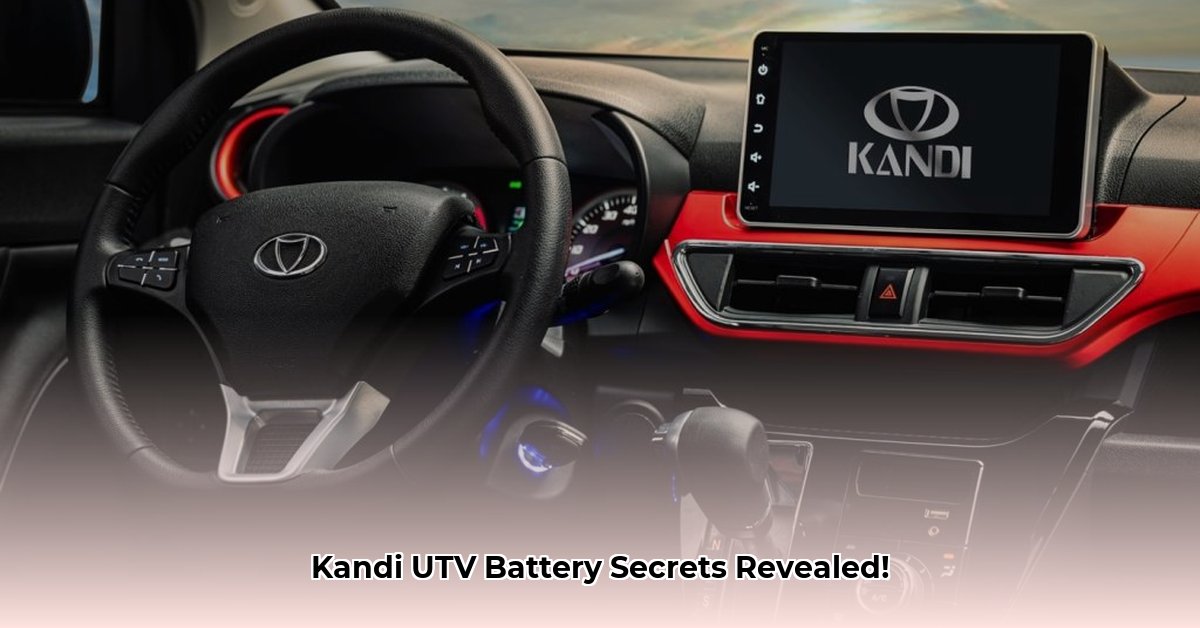Decoding Your Kandi UTV’s Battery: Specs, Lifespan, and More
Kandi UTVs offer thrilling off-road adventures, but information about their batteries—specifically cell counts—remains surprisingly elusive. This comprehensive guide aims to demystify your Kandi UTV’s battery, providing essential specifications, maintenance tips, and troubleshooting advice. We’ll delve into the critical cell count data, explaining its significance and how it relates to your UTV’s performance.
Kandi UTV Battery Specifications by Model
This section breaks down the battery specifics for each Kandi UTV model. We’re actively working to obtain precise cell count data directly from Kandi America. This information is crucial for understanding the battery’s internal configuration and potential for future modifications or repairs.
Kandi K27
- Battery kWh: 17.69 kWh
- Battery Type: Lithium-ion (likely)
- Estimated Range: 70-85 miles (real-world reports suggest lower than the initially advertised 100 miles)
- Charging Time (240V): Approximately 7 hours
- Cell Count: Awaiting confirmation from Kandi America
- Cell Type: Awaiting confirmation from Kandi America
Kandi e10K / Cowboy E10K / Innovator E10K
These models appear to share similar battery specifications:
- Battery kWh: 11.52 kWh
- Battery Type: Lithium-ion (likely)
- Estimated Range: ~60 miles
- Charging Time (120V): Approximately 8 hours
- Cell Count: Awaiting confirmation from Kandi America
- Cell Type: Awaiting confirmation from Kandi America
Lucky T9 Buggy
- Battery kWh: 15.36 kWh
- Battery Type: Lithium-ion (likely)
- Estimated Range: Not yet confirmed, but likely higher than the e10K given the larger kWh rating.
- Charging Time: Not yet confirmed.
- Cell Count: Awaiting confirmation from Kandi America
- Cell Type: Awaiting confirmation from Kandi America
Pending Data Confirmation from Kandi America: We will update the table below with confirmed data as soon as it becomes available.
| Model | kWh | Voltage | Cell Count | Cell Type |
|---|---|---|---|---|
| Kandi K27 | 17.69 | TBD | TBD | TBD |
| Lucky T9 | 15.36 | TBD | TBD | TBD |
| e10K/Cowboy/Innovator | 11.52 | TBD | TBD | TBD |
Understanding Battery Basics: kWh, Voltage, and Cell Count
Kilowatt-hours (kWh): This measures the battery’s capacity, analogous to the size of a fuel tank. A higher kWh generally means a longer driving range. However, real-world range can vary due to driving style, terrain, and temperature.
Voltage (V): Voltage is the electrical potential difference, or “pressure,” that drives the flow of electricity. Higher voltage can lead to increased power and efficiency.
Cell Count: Individual lithium-ion cells are connected in series and parallel to form a battery pack. The cell count, along with the individual cell characteristics (voltage and amp-hour rating), determines the overall battery pack voltage and kWh rating.
Maintaining Your Kandi UTV Battery
Proper maintenance is essential for maximizing battery life and performance.
1. Terminal Cleaning: Regularly inspect and clean the battery terminals with a wire brush and a mixture of baking soda and water to remove corrosion.
2. Connection Check: Ensure all battery cables are securely connected and free from damage.
3. Smart Storage: For extended storage, store the battery in a cool, dry place, ideally at a 40-60% state of charge. Avoid storing a fully charged or completely discharged battery for long periods.
Lithium-ion Battery Safety Precautions
- Disconnect First: Always disconnect the battery before performing any maintenance or repairs.
- Protective Gear: Wear insulated gloves and eye protection.
- Handle with Care: Never puncture, crush, or mishandle the battery.
- Professional Assistance: Consult a qualified technician for complex repairs or modifications.
Troubleshooting Common Battery Issues
- Reduced Range: This can be influenced by driving habits, terrain, and temperature. A sudden, significant drop in range might indicate a battery problem.
- Charging Problems: Check the charger, charging cable, and battery connections.
- UTV Won’t Start: Check battery connections and voltage. A low voltage reading suggests a discharged or potentially faulty battery.
If simple troubleshooting doesn’t resolve the issue, consult a qualified technician.
FAQs: Addressing Your Battery Questions
We’re compiling a comprehensive FAQ section. Here are some preliminary answers:
- Battery Lifespan: Lithium-ion batteries typically last a few years, but actual lifespan is heavily influenced by usage and charging habits. Kandi’s 8-year/62,000-mile warranty on the K27 suggests a reasonable expected life under normal conditions.
- Replacement Costs: We’re researching current market prices for Kandi UTV battery replacements. We’ll update this section with cost estimates soon.
Disclaimer
This guide is for informational purposes only. Working with high-voltage batteries can be dangerous. Always consult a qualified technician for any repairs or modifications if you are unsure. We assume no responsibility for any damage or injury resulting from the information provided here.
No videos found for the given keyword.
- How Did Charles F. Brush Discover Wind Energy Tech? - November 19, 2025
- Wind Energy Vertical: Weighing the Pros and Cons of Wind Power - November 16, 2025
- How Much Energy Does a Wind Turbine Actually Create? - November 14, 2025
















